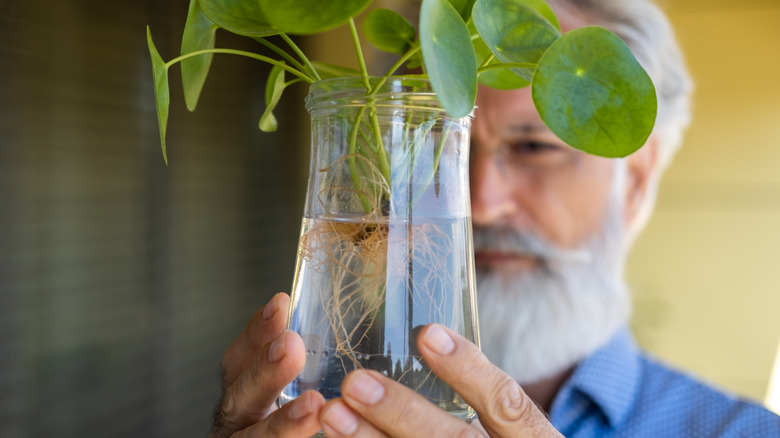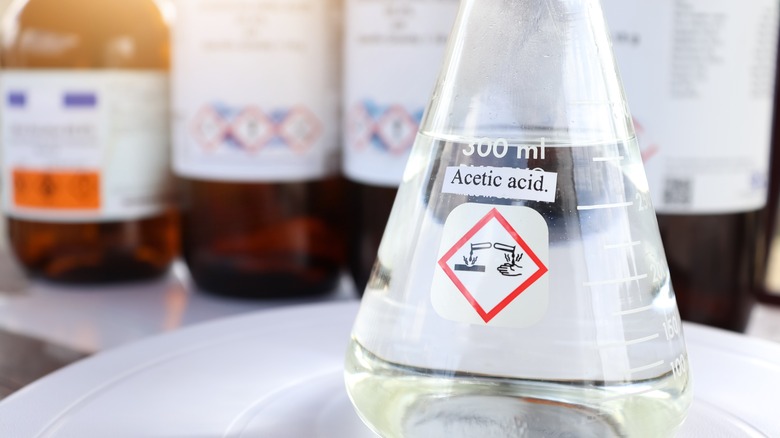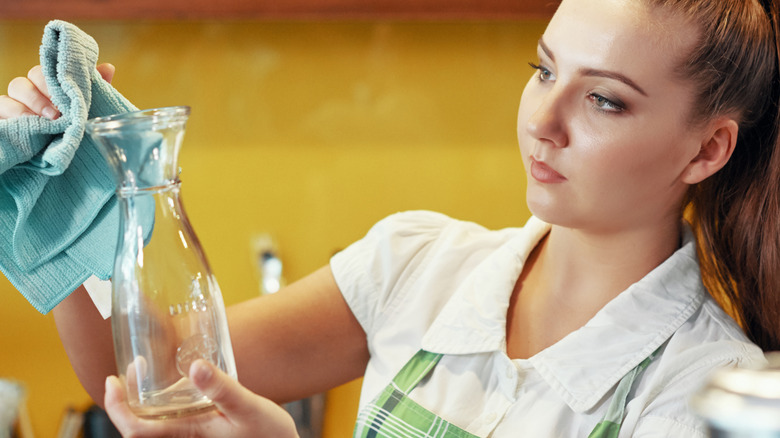Get Mineral Buildup Off Of Glass Planters With One Common Kitchen Ingredient
By now, you're probably aware that vinegar can be a versatile cleaning tool. Want streak-free mirrors? Wipe them down with vinegar. Got a clogged shower head? Soak it in, you guessed it, vinegar! As it turns out, this dirt-cheap, food-safe kitchen product is also helpful for your indoor garden. If you're employing transparent glass jars, containers, or planters to propagate herbs, re-grow veggie scraps, or house a clambering pothos, you've probably noticed the hard, white residue that collects on the sides. A good wipe with a vinegar-soaked cloth will take that right off.
The staining is caused by minerals like calcium and magnesium building up on the surface of the glass. It's prevalent in areas supplied by hard water, such as the U.S. Midwest, though it can happen with soft water, too, given enough time. Bacteria, which proliferate in infrequently changed water filled with organic matter (your plants' roots and fallen leaves), contribute their own discoloration.
The active ingredient in vinegar — that is, what makes it so useful for cleaning — is acetic acid. It's created during the double-fermentation process that vinegar (or the alcohol and water mixture it's made of) goes through. Acetic acid breaks down stains and creates an inhospitable environment for bacteria and fungi (think mold) — though the latter is not a use approved by the EPA.
Will it harm my plants?
Before you take to your vase with a vinegar-soaked cloth, you might be wondering whether it's safe for your precious plant babies. The short answer is yes — with the caveat that you only use kitchen vinegar, dilute it in water, and rinse the vase or planter well before popping your plant back into it. According to Indiana Yard and Garden, a Purdue University blog, vinegar with concentrations of acetic acid above 5% has successfully been used as an herbicide. If you spray highly concentrated vinegar directly onto a plant's leaves or stem, you will kill it.
Thankfully, kitchen vinegar has acetic acid levels well below that threshold. Plus, you're using it on the container your plant lives in, not the plant itself. Vinegar cleans glass well, but what about other transparent containers? Most plastics don't react with vinegar; use it to safely clean vases made of acrylic to PET. Just don't let the vinegar come into contact with rubber or metal parts — these materials deteriorate with repeated exposure to acetic acid. It's also safe to clean vessels made of rock crystal with vinegar.
Get cleaning
If you're ready to try this vinegar trick, you first need to gather your supplies. You'll need a clean rag or dishcloth, paper towels or a spare planter, some fresh water, and, of course, some vinegar. Only purchase white vinegar, like this 128 fluid-ounce Great Value bottle, for $3.76 at Walmart. Of all the kinds of vinegar out there, this one is ideal for cleaning. Other vinegar — wine, balsamic, or apple cider — just aren't economical options. And, except for perhaps apple cider vinegar, their cleaning power is unproven. Malt vinegar is cheap, but its distinctive dark brown color can exacerbate stains.
Find a clean container to keep your house plant in temporarily. Alternatively, you can gently wrap its roots in some damp paper towels. Put it in a safe spot out of direct sunlight. Dilute your vinegar by half with water and dip your rag into it. Wipe the rag over the affected area — where you see mineral residue and stains — until the discoloration disappears. This may take a little scrubbing and a few minutes. You can also soak a small planter in the vinegar solution for 30 minutes and then wipe the surface with a cloth. Rinse the vase thoroughly in cold water and dry with a lint-free towel before repotting your plant.


